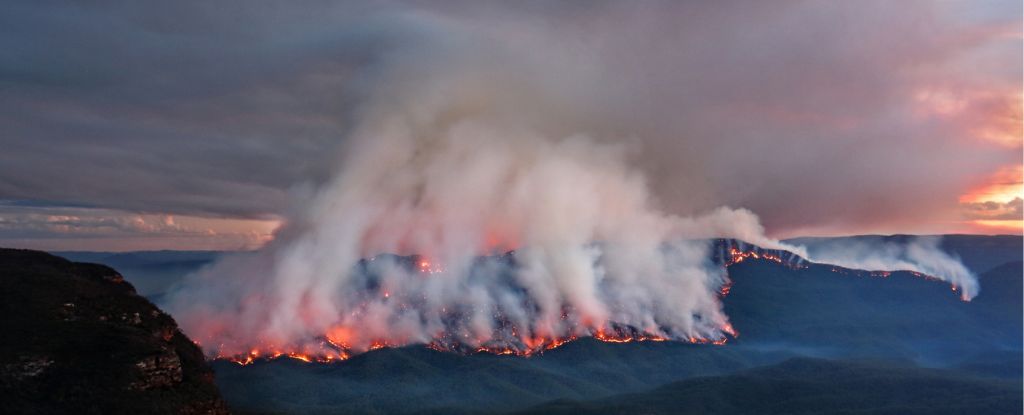Products You May Like
The smoke from recent wildfires is threatening to slow and even reverse the recovery of Earth’s ozone layer – the same one that the world has worked so hard to heal since 1987.
The ozone layer is a crucial part of the stratosphere that stops our planet from getting scorched by the Sun’s radiation.
It’s important for the health of all plants and animals that it stays intact, yet thanks to the historical use of synthetic pollutants called chlorofluorocarbons (CFCs), there’s a big old hole in Earth’s atmospheric armor, right over Antarctica.
Thanks to an international agreement to ban CFCs in 1987, the hole in the ozone is gradually shrinking. In 2019, the opening was the smallest on record since 1982, when it was first discovered.
It’s one of humanity’s greatest success stories. But it’s not over yet.
In 2021, the hole above Antarctica began to swell once again – a year after the devastating megafires that burned 60 million acres of vegetation in Australia.
And that’s probably no coincidence.
A new study on Australia’s recent megafires has found smoke particles in the stratosphere could deplete the ozone layer for well over a year. As the particles age, they may even become more destructive.
The findings help explain why there seems to be such a lag effect on the ozone layer’s thickening following wildfire activity.
The 2019/2020 Australia fires pumped more than a million tons of smoke into the atmosphere.
It took until August 2020, however, for scientists to notice the hole in the ozone rapidly growing.
Researchers now estimate that by September, smoke particles had widened the ozone hole by roughly 2.5 million square kilometers – 10 percent bigger than the year before.
“The Australian fires of 2020 were really a wake-up call for the science community,” says climate scientist Susan Solomon from MIT, who has been working on ozone depletion for decades.
“The effect of wildfires was not previously accounted for in [projections of] ozone recovery. And I think that effect may depend on whether fires become more frequent and intense as the planet warms.”
In just the last two decades, the top four largest wildfires in human history have occurred on both hemispheres.
The 2003 Siberian Taiga fires in Russia were the largest ever recorded. They burned 55 million acres. The more recent Australian bushfires are a close second place.
Both of these natural disasters were ultimately followed by significant erosion of the ozone layer, and yet how wildfire smoke depletes the ozone is still unclear.
Solomon is determined to find out. In the early 2000s, she was a leading scientist in the discovery on how CFCs deplete the ozone. Now, she’s tackling the issue of smoke.
In 2022, Solomon and her colleagues showed that wildfire smoke can cause nitrogen dioxide levels in the stratosphere to plummet, essentially kicking off the domino effect that ultimately drives chemical depletion of the ozone.
“Once you have less nitrogen dioxide, you have to have more chlorine monoxide, and that will deplete ozone,” Solomon explained at the time.
“But that didn’t explain all the changes that were observed in the stratosphere,” she says now.
“There was a whole bunch of chlorine-related chemistry that was totally out of whack.”
So Solomon and her team took a closer look at the chemical reactions at play. Using satellite data, they tracked the conditions of the stratosphere above Antarctica in the months following Australia’s fires.
At first, they saw hydrochloric acid (HCl) in the atmosphere drop and chlorine monoxide spike. This essentially implied that HCl was somehow breaking apart, allowing its chlorine free to mess around with oxygen and cause destruction in the ozone.
In simulations, it seemed that wildfire smoke was causing this effect.
“It’s the aged smoke particles that really take up a lot of the HCl,” Solomon says.
“And then you get, amazingly, the same reactions that you get in the ozone hole… “
That’s not a good sign in a climate crisis. If wildfires become frequent enough that the ozone has no time to heal from the detrimental effects of smoke, its health could easily relapse.
Especially since forbidden CFC emissions have also been detected rising in the past few years.
As long as we want to thrive on Earth, we will need the ozone layer to survive. Keeping it in good health isn’t a short-term project, it’s a lifelong commitment.
The study was published in Nature.
